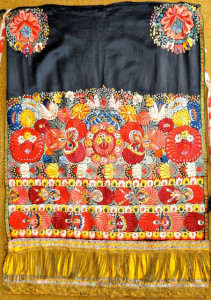MATYÓ EMBROIDERY OF MEZŐKÖVESD

In Hungary embroidery played a great part in the upbringing of every girl. It didn’t matter, if she lived in a castle or a peasant hut. The oldest existing embroidery in Europe is the Hungarian Coronation robe, dated 1031. Ever since then all women and girls have been embroidering and beautifying their clothes and surroundings. There are various regions and towns that have there unique embroidery style, which can be recognized by the difference in design, technique and coloring.
Therefore, it is not surprising to see such rich embroidered material from one relatively small town of 20 000. Mezőkövesd is the town in question. It is located at the northern edge of the Great Hungarian Plain, and was already mentioned in documents in the 13th century.
There are two kinds of embroidery in Hungary: women’s linen embroidery and men’s embroidery. In Mezőkövesd the two intertwine. It’s embroidery was the same as in neighboring communities of the region up to the middle of the 19th century. It was done in white on white, later they added some red and blue. Then came the change which made them especially famous. Their colorful rich embroideries have their origin in the furrier embroidery. All over Hungary, women and men alike, wore embroidered sheepskin jackets. In Mezőkövesd the embroidery was so rich, that the base material (leather) could not be seen. This kind of embroidery was done exclusively by men for centuries. To be a furrier was a family trade, passed from father to son. In the last century there lived a furrier in Mezőkövesd who had so much work, that not only his two sons but his daughter had to help out too. And then one day she started to use the beautiful furrier embroidery designs on her own work, naturally modifying them some. She not only used her father’s designs and furrier silk, but adapted the many colors of leather embroidery to her own. Her neighbors liked the new colorful designs so much, that they soon asked her to draw or “write” for them too. Kis Jankó Bori and later her daughter by the same name, two extremely talented persons, revolutionized the embroidery style of Mezőkövesd completely. By the end of the 19th century their work was already internationally known. The women of Mezőkövesd preferred to apply their new patterns on large smooth pieces of material, like sheet ends and aprons.
There are over 500 flower motifs known. Kis Jankó Bori, when ever she saw a flower in her garden could sit down and draw it ready for embroidery. She could stylize it immediately in a manner which is quite unique. Men and women started to wear richly embroidered aprons using black material (the color of earth), which accented the flowers of many colors even more.
There is a story about these aprons. Once a girl wanted to marry in winter. Her fiancé said: “I shall marry you if you will give me a basket or apron full of flowers.” After she did some thinking, she came up with the idea to give him flowers, which would never wilt. She took a piece of black material and covered it with beautifully embroidered flowers. The wedding took place. Ever since then not only men, but also women wear these richly embroidered aprons, which accentuate the elegant, relatively tall stature of the Matyó people.
